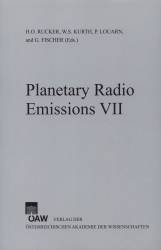
Planetary Radio Emissions VII, pp. 115-124, 2011/12/28
Proceedings of the 7th International Workshop on Planetary, Solar and Heliospheric Radio Emissions held at Graz, Austria, September 15–17, 2010

After Cassini’s arrival at planet Saturn, its Radio and Plasma Wave Science (RPWS) experiment has performed numerous observations of a new type of planetary radio emissions in the lower kHz frequency range (< 50kHz). These bursty emissions have time scales of a few to 15 minutes and occur as slowly drifting events in the time-frequency spectrogram. They have neither been detected by the Voyager spacecraft nor by Ulysses. As a first approach to this new phenomenon, results of a statistical study with regard to the observer’s position, i.e. Cassini’s orbital position, will be presented. Furthermore, aspects of polarization will be highlighted as far as appropriate goniopolarimetric (3-antenna) observations are available.